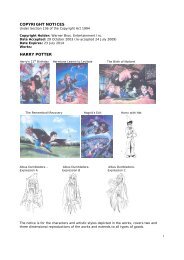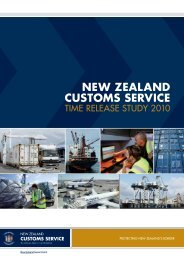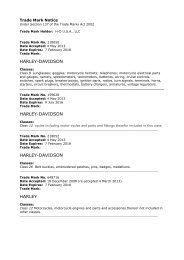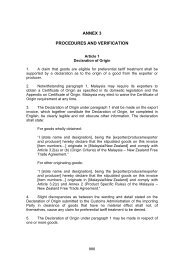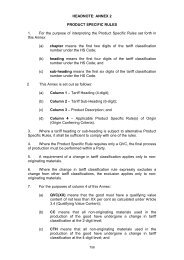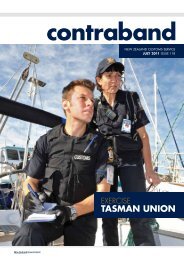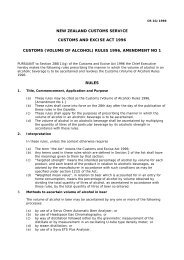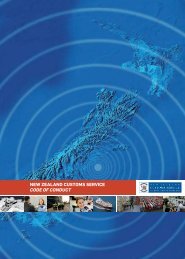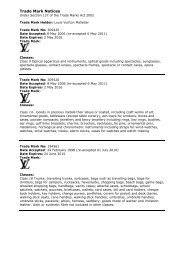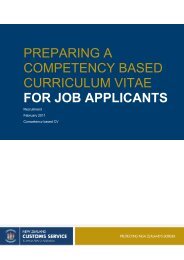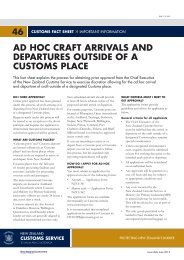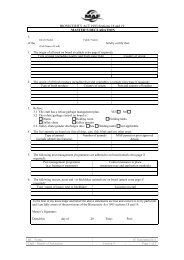TSW Project Industry Consultation Paper - New Zealand Customs ...
TSW Project Industry Consultation Paper - New Zealand Customs ...
TSW Project Industry Consultation Paper - New Zealand Customs ...
- No tags were found...
You also want an ePaper? Increase the reach of your titles
YUMPU automatically turns print PDFs into web optimized ePapers that Google loves.
APPENDIX 1: EXISTING BUSINESS PROCESSES FOR TRANSHIPMENTSA. International TranshipmentsNB: Some in the industry call this “transhipment” cargo. We are referring to goodsthat arrive in <strong>New</strong> <strong>Zealand</strong> en route to another country, and are transferred to adifferent vessel or aircraft (either at the same port/airport or at a differentport/airport) for export, without being cleared for delivery in <strong>New</strong> <strong>Zealand</strong>.Existing business process:MAF:• There is a combination of manual manifest or air waybill screening and onwharf/airportsurveillance/inspection activity to determine the risk status of suchconsignments.• If the goods are being offloaded and remaining in the airport environs or on a wharfto be transferred onto another craft, then no BACC application is required as therelevant airline/port system will maintain security of the goods.• Otherwise, for risk goods, a BACC with specific conditions that may involve inspectionprior to the goods leaving the cargo store/wharf is issued. Evidence of re-export isalso required.• Note: the live animals process is different.<strong>Customs</strong>:• An export delivery order is required to authorise loading onto the export craft. Wherethe transhipment requirements are already known and a consignment is tagged assuch on the importing craft’s Inward Cargo Report (ICR), <strong>Customs</strong> can processrelevant fields and electronically authorise loading for transhipment.• However, as the current ICR format is not suited to this (there is no field for theexport craft or export BoL/awb number), a freight forwarder often submits a specificExport ECI report in order to gain an export delivery order.• Where the transhipment air waybill for export from <strong>New</strong> <strong>Zealand</strong> is cut in <strong>New</strong><strong>Zealand</strong>, a specific Export ECI report is required to be submitted in order to gain anexport delivery order.• Neither facility is sufficient for border management objectives.B. Domestic TranshipmentsNB: In regard to <strong>Customs</strong>’ requirements, this has historically been referred to asan “under bond movement” or “domestic transhipment” or “transhipment forremoval within NZ”. MAF sometimes calls it a “transfer”. We are referring to goodsthat arrive in <strong>New</strong> <strong>Zealand</strong> and are intended for final delivery in <strong>New</strong> <strong>Zealand</strong>, butneed to be transferred from the place of arrival to a CCA/Transitional Facility orimporter’s premises, or transferred from one CCA/TF to another, before beingcleared for “home consumption” e.g. an LCL container moving from a port to afreight forwarder’s CCA for de-consolidation; or to a TF for treatment.Existing business process:MAF:• Again, there is a combination of manual manifest and air waybill screening and onwharf/airportsurveillance/inspection activity to determine the risk status of suchconsignments.20 March 2012 #8881 JBMS <strong>TSW</strong> <strong>Industry</strong> <strong>Consultation</strong> Page 25 of 26



